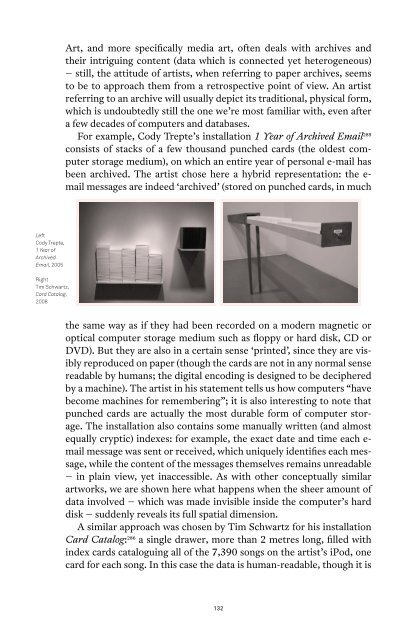Post- Digital Print - Monoskop
Post- Digital Print - Monoskop
Post- Digital Print - Monoskop
Create successful ePaper yourself
Turn your PDF publications into a flip-book with our unique Google optimized e-Paper software.
Left<br />
Cody Trepte,<br />
1 Year of<br />
Archived<br />
Email, 2005<br />
Right<br />
Tim Schwartz,<br />
Card Catalog,<br />
2008<br />
Art, and more specifically media art, often deals with archives and<br />
their intriguing content (data which is connected yet heterogeneous)<br />
– still, the attitude of artists, when referring to paper archives, seems<br />
to be to approach them from a retrospective point of view. An artist<br />
referring to an archive will usually depict its traditional, physical form,<br />
which is undoubtedly still the one we’re most familiar with, even after<br />
a few decades of computers and databases.<br />
For example, Cody Trepte’s installation 1 Year of Archived Email 285<br />
consists of stacks of a few thousand punched cards (the oldest computer<br />
storage medium), on which an entire year of personal e-mail has<br />
been archived. The artist chose here a hybrid representation: the email<br />
messages are indeed ‘archived’ (stored on punched cards, in much<br />
the same way as if they had been recorded on a modern magnetic or<br />
optical computer storage medium such as floppy or hard disk, CD or<br />
DVD). But they are also in a certain sense ‘printed’, since they are visibly<br />
reproduced on paper (though the cards are not in any normal sense<br />
readable by humans; the digital encoding is designed to be deciphered<br />
by a machine). The artist in his statement tells us how computers “have<br />
become machines for remembering”; it is also interesting to note that<br />
punched cards are actually the most durable form of computer storage.<br />
The installation also contains some manually written (and almost<br />
equally cryptic) indexes: for example, the exact date and time each email<br />
message was sent or received, which uniquely identifies each message,<br />
while the content of the messages themselves remains unreadable<br />
– in plain view, yet inaccessible. As with other conceptually similar<br />
artworks, we are shown here what happens when the sheer amount of<br />
data involved – which was made invisible inside the computer’s hard<br />
disk – suddenly reveals its full spatial dimension.<br />
A similar approach was chosen by Tim Schwartz for his installation<br />
Card Catalog: 286 a single drawer, more than 2 metres long, filled with<br />
index cards cataloguing all of the 7,390 songs on the artist’s iPod, one<br />
card for each song. In this case the data is human-readable, though it is<br />
132

















